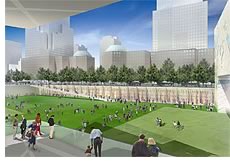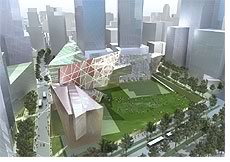

Ground Zero Memorial
Competition Launched
Maya Lin, Enrique Norten to serve as jurors
 Lower
Manhattan redevelopment planners launched the design competition for the
World Trade Center Memorial April 28. The international program is advertised
in a media campaign in 22 languages to solicit design ideas from anyone
over the age of 18, as well as from children and teens who work with an
adult.
Lower
Manhattan redevelopment planners launched the design competition for the
World Trade Center Memorial April 28. The international program is advertised
in a media campaign in 22 languages to solicit design ideas from anyone
over the age of 18, as well as from children and teens who work with an
adult.
The Lower Manhattan Development Corporation (LMDC) published a Web site and released official competition guidelines for the September 11 memorial at Ground Zero. The competition registration deadline is May 29 and requires a $25 processing fee. Designs, limited to illustrations and text on a 30-by-40-inch presentation board, can be submitted between June 9 and June 30. Registrants will not include their name in their presentations, rather, they will be assigned a number to include with the design.
From July through August, during the first part of the two-stage competition, a 13-member jury, including designers May Lin, Michael Van Valkenburgh, and Enrique Norten, Assoc. AIA, will review the anonymous submissions and select finalists. During the second stage, the finalists will further develop their design proposals, which the LMDC will reveal to the public, and the jury will continue its deliberations. The winning designs are slated to be announced in fall 2003.
The memorial competition announcement comes two months after state and local officials chose the Studio Daniel Libeskind’s $350 million, 16-acre site plan, featuring a 1,776-foot-tall single-tower and the slurry walls of the original towers, for the redevelopment of the World Trade Center site. Libeskind placed the memorial on nearly five acres in the bathtub of the towers. Most recently, on April 24, New York Gov. George E. Pataki laid out an ambitious construction schedule, saying that he expects the exterior of the Libeskind’s tower, transportation improvements, and the substructure of the memorial to be completed by September 2004. He said he wants the governor’s New York City office to be the building’s first tenant.
The New York Times also reports that Pataki said the LMDC would work to get arts institutions to move to the new cultural buildings that will be built at ground zero. The paper also noted the dates for completion of other critical projects: the permanent PATH station, to open in late 2006; the Fulton Transit Center, to open in 2007; and the underground pedestrian tunnels connecting the two stations and the World Financial Center, to open in 2009. The paper reported Pataki’s intent to have developer Larry A. Silverstein, who holds the lease to office space at the site and who also already has committed to rebuilding 7 World Trade Center next door, build the new tower.
 Distinguished
jury
Distinguished
jury
The LMDC also announced the 13 jurors who will review the design proposals.
The panel will include Lin, perhaps best known for her designs of the
Vietnam Veterans’ Memorial in Washington, D.C., and Civil Rights
Memorial in Montgomery, Ala.; Norten, founder of Taller de Enrique Norten
Arquictectos S.C. (TEN Arquitectos) with Bernardo Gomez-Pimienta; and
Van Valkenburgh, Michael Van Valkenburgh Architects, New York City and
Cambridge, Mass. Van Valkenburgh’s firm has won national design
awards from the American Society of Landscape Architects and a Progressive
Architecture Award in 1997 for Allegheny Riverfront Park. Most
recently, the National Capital Planning Commission endorsed his proposal
for the development of Pennsylvania Avenue in front of the White House.
The other jurors are Paula Grant Berry, a member of the LMDC Families Advisory Council and Memorial Program Drafting Committee, whose husband, David, perished in the south tower; Susan Freedman, president of the Public Art Fund; Dr. Vartan Gregorian, president of the Carnegie Corporation of New York; Patricia Harris, NYC’s deputy mayor for administration; Julie Menin, Wall Street Rising founder and financial district resident; artist and MacArthur Genius Grant winner Martin Puryear; long-time art consultant Nancy Rosen; Lowery Stokes Sims, executive director of the Studio Museum in Harlem; and Holocaust studies and memorial expert Dr. James Young.
The LMDC has asked the jury to evaluate the designs based on how they express the defined purpose and principles of the memorial, and use specific elements. AIA New York Chapter Executive Director Frederic Bell, FAIA, was on the committee that wrote the program.
The mission statement and program were released for public feedback earlier this year and were revised based on more than 2,000 comments received during that period. The drafts were developed by two separate committees, convened by the LMDC and composed of family members, residents, survivors, first responders, arts and architecture professionals, and community leaders. The jury will take part in a series of public forums this summer to get comments on how elements in the mission and program should be incorporated into the winning design.
Copyright 2003 The American Institute of Architects.
All rights reserved. Home Page ![]()
![]()
 |
||
| Click here to link to the guidelines for the World Trade Center memorial competition. Click here to read the jury members’ full biographies. Daniel Libeskind will be a featured speaker at the AIA’s national convention in San Diego May 10. The architect will join panelists Frances Halsband, FAIA, founding partner, R.M. Kliment & Frances Halsband Architects; Stanton Eckstut, FAIA, founding principal of Ehrenkrantz, Eckstut & Kuhn; and Paul Goldberger, Hon. AIA, Pulitzer-prize-winning architecture critic at the New Yorker, in a discussion about the issues surrounding the development of the World Trade Center site. Robert Ivy, FAIA, editor in chief of Architectural Record, will moderate the panel discussion. In addition, a mounted presentation featuring elements of Libeskind's proposal for the redevelopment of the World Trade Center site will be displayed in the convention registration area.
|
||